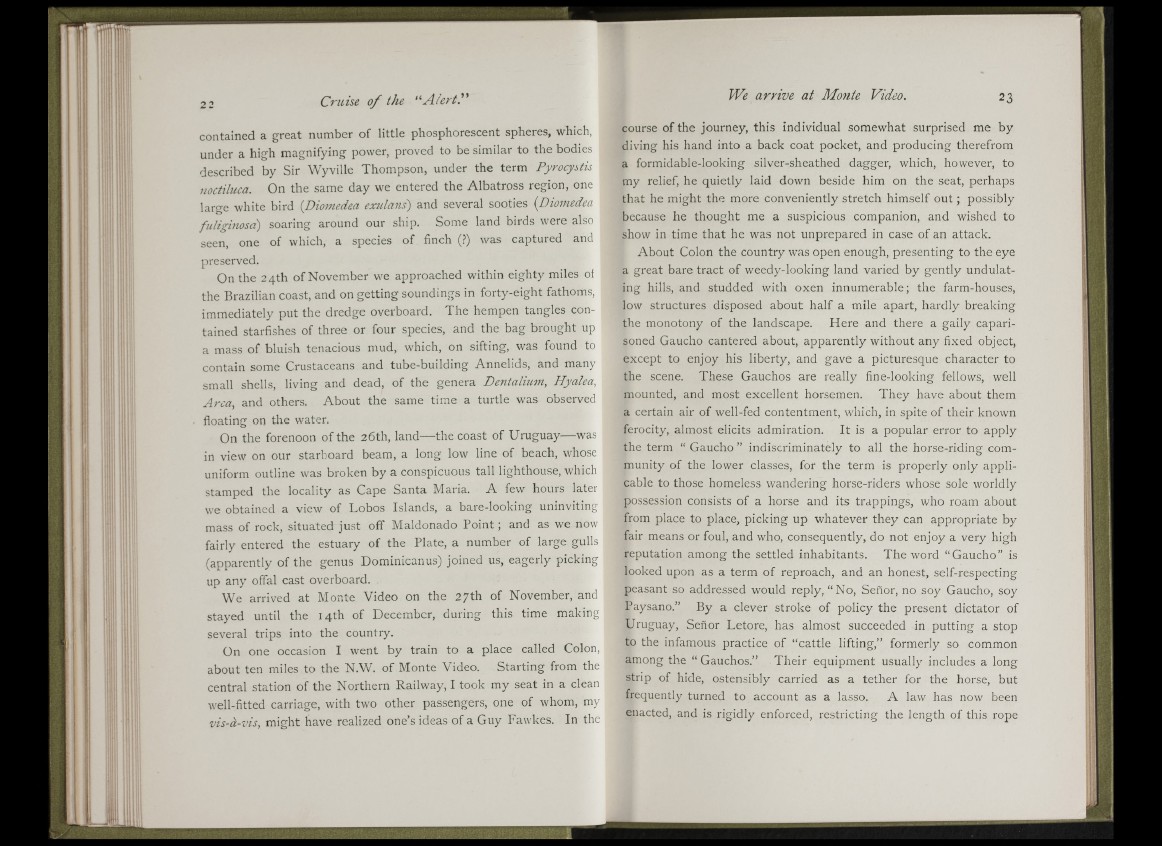
III
!
I *
I i
22 Cruise o f the “ Ale rti
contained a great number of little phosphorescent spheres, which,
under a high magnifying power, proved to be similar to the bodies
described by Sir Wyville Thompson, under the term Pyrocystis
noctiluca. On the same day we entered the Albatross region, one
large white bird {Diomedea exnlan.i) and several sooties {Diomedea
fuliginosa) soaring around our ship. Some land birds were also
seen, one of which, a species of finch (?) was captured and
preserved.
On the 24th of November we approached within eighty miles oi
the Brazilian coast, and on getting soundings in forty-eight fathoms,
immediately put the dredge overboard. The hempen tangles contained
starfishes of three or four species, and the bag brought up
a mass of bluish tenacious mud, which, on sifting, was found to
contain some Crustaceans and tube-building Annelids, and many
small shells, living and dead, of the genera Dentalium, Hyalea,
Area, and others. About the same time a turtle was observed
floating on the water.
On the forenoon of the 26th, land— the coast of Uruguay— was
in view on our starboard beam, a long low line of beach, whose
uniform outline was broken by a conspicuous tall lighthouse, which
stamped the locality as Cape Santa Maria. A few hours later
we obtained a view of Lobos Islands, a bare-looking uninviting
mass of rock, situated just off Maldonado Point ; and as we now
fairly entered the estuary of the Plate, a number of large gulls
(apparently of the genus Dominicanus) joined us, eagerly picking
up any offal cast overboard.
We arrived at Monte Video on the 27th of November, and
stayed until the 14th of December, during this time making
several trips into the country.
On one occasion I went by train to a place called Colon,
about ten miles to the N.W. of Monte Video. Starting from the
central station of the Northern Railway, I took my seat in a clean
well-fitted carriage, with two other passengers, one of whom, my
vis-à-vis, might have realized one’s ideas of a Guy Fawkes. In the
We arrive at Monte Video. 23
course of the journey, this individual somewhat surprised me by
diving his hand into a back coat pocket, and producing therefrom
a formidable-looking silver-sheathed dagger, which, however, to
my relief, he quietly laid down beside him on the seat, perhaps
that he might the more conveniently stretch himself o u t ; possibly
because he thought me a suspicious companion, and wished to
show in time that he was not unprepared in case of an attack.
About Colon the country w^as open enough, presenting to the eye
a great bare tract of weedy-looking land varied by gently undulating
hills, and studded with oxen innumerable; the farm-houses,
low structures disposed about half a mile apart, hardly breaking
the monotony of the landscape. Here and there a gaily caparisoned
Gaucho cantered about, apparently without any fixed object,
except to enjoy his liberty, and gave a picturesque character to
the scene. These Gauchos are really fine-looking fellows, well
mounted, and most excellent horsemen. They have about them
a certain air of well-fed contentment, which, in spite of their known
ferocity, almost elicits admiration. It is a popular error to apply
the term “ Gaucho ” indiscriminately to all the horse-riding community
of the lower classes, for the term is properly only applicable
to those homeless wandering horse-riders whose sole worldly
possession consists of a horse and its trappings, who roam about
from place to place, picking up whatever they can appropriate by
fair means or foul, and who, consequently, do not enjoy a very high
reputation among the settled inhabitants. The word “ Gaucho” is
looked upon as a term of reproach, and an honest, self-respecting
peasant so addressed would reply, “ No, Señor, no soy Gaucho, soy
Paysano.” By a clever stroke of policy the present dictator of
Uruguay, Señor Letore, has almost succeeded in putting a stop
to the infamous practice of “ cattle lifting,” formerly so common
among the “ Gauchos.” Their equipment usually includes a long
strip of hide, ostensibly carried as a tether for the horse, but
frequently turned to account as a lasso. A law has now been
enacted, and is rigidly enforced, restricting the length of this rope